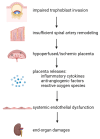The Roles of Obesity and ASB4 in Preeclampsia Pathogenesis
- PMID: 39201703
- PMCID: PMC11354233
- DOI: 10.3390/ijms25169017
The Roles of Obesity and ASB4 in Preeclampsia Pathogenesis
Abstract
Preeclampsia is a complex pregnancy-related hypertensive disorder which poses significant risks for both maternal and fetal health. Preeclampsia affects 5-8% of pregnancies in the United States, causing a significant public health and economic burden. Despite extensive research, the etiology and pathogenesis of preeclampsia remain elusive, but have been correlated with maternal conditions such as obesity. In recent decades, the incidence of preeclampsia increased along with the prevalence of obesity among women of reproductive age. Maternal obesity has been shown to negatively affect pregnancy in almost all aspects. However, the precise mechanisms by which obesity influences preeclampsia are unclear. Ankyrin repeat and SOCS Box Containing protein 4 (ASB4) is an E3 ubiquitin ligase that can promote the degradation of a wide range of target proteins. ASB4-null mice display a full spectrum of preeclampsia-like phenotypes during pregnancy including hypertension, proteinuria, and decreased litter size. Furthermore, maternal obesity induced by a high-fat diet aggravates preeclampsia-like phenotypes in pregnant mice lacking ASB4. Variants in the ASB4 gene have been associated with obesity in humans, and a functional connection between the ASB4 gene and obesity has been established in mice. This review discusses the connections between preeclampsia, obesity, and ASB4.
Keywords: ASB4; endometrium; implantation; insulin; leptin; obesity; preeclampsia; trophoblast.
Conflict of interest statement
The authors declare no conflicts of interest.
Figures


Similar articles
-
Insulin Elevates ID2 Expression in Trophoblasts and Aggravates Preeclampsia in Obese ASB4-Null Mice.Int J Mol Sci. 2023 Jan 21;24(3):2149. doi: 10.3390/ijms24032149. Int J Mol Sci. 2023. PMID: 36768469 Free PMC article.
-
The ubiquitin ligase ASB4 promotes trophoblast differentiation through the degradation of ID2.PLoS One. 2014 Feb 21;9(2):e89451. doi: 10.1371/journal.pone.0089451. eCollection 2014. PLoS One. 2014. PMID: 24586788 Free PMC article.
-
ASB4 is a hydroxylation substrate of FIH and promotes vascular differentiation via an oxygen-dependent mechanism.Mol Cell Biol. 2007 Sep;27(18):6407-19. doi: 10.1128/MCB.00511-07. Epub 2007 Jul 16. Mol Cell Biol. 2007. PMID: 17636018 Free PMC article.
-
Increased risk for the development of preeclampsia in obese pregnancies: weighing in on the mechanisms.Am J Physiol Regul Integr Comp Physiol. 2015 Dec 1;309(11):R1326-43. doi: 10.1152/ajpregu.00178.2015. Epub 2015 Oct 7. Am J Physiol Regul Integr Comp Physiol. 2015. PMID: 26447211 Free PMC article. Review.
-
Preeclampsia: Recent Advances in Predicting, Preventing, and Managing the Maternal and Fetal Life-Threatening Condition.Int J Environ Res Public Health. 2023 Feb 8;20(4):2994. doi: 10.3390/ijerph20042994. Int J Environ Res Public Health. 2023. PMID: 36833689 Free PMC article. Review.
Cited by
-
Pathophysiology of Maternal Obesity and Hypertension in Pregnancy.J Cardiovasc Dev Dis. 2025 Mar 3;12(3):91. doi: 10.3390/jcdd12030091. J Cardiovasc Dev Dis. 2025. PMID: 40137089 Free PMC article. Review.
References
Publication types
MeSH terms
Substances
Grants and funding
LinkOut - more resources
Full Text Sources
Medical
Molecular Biology Databases

